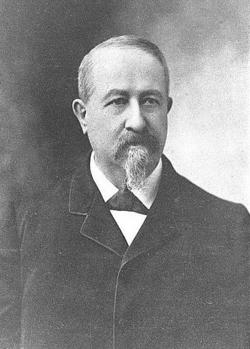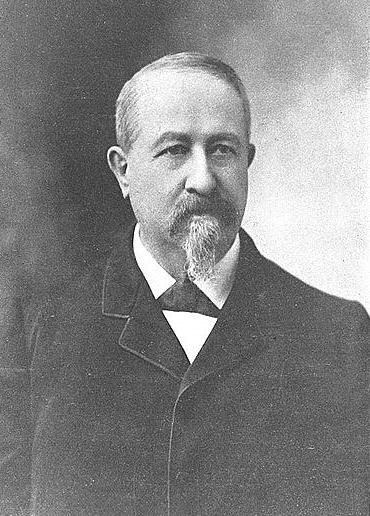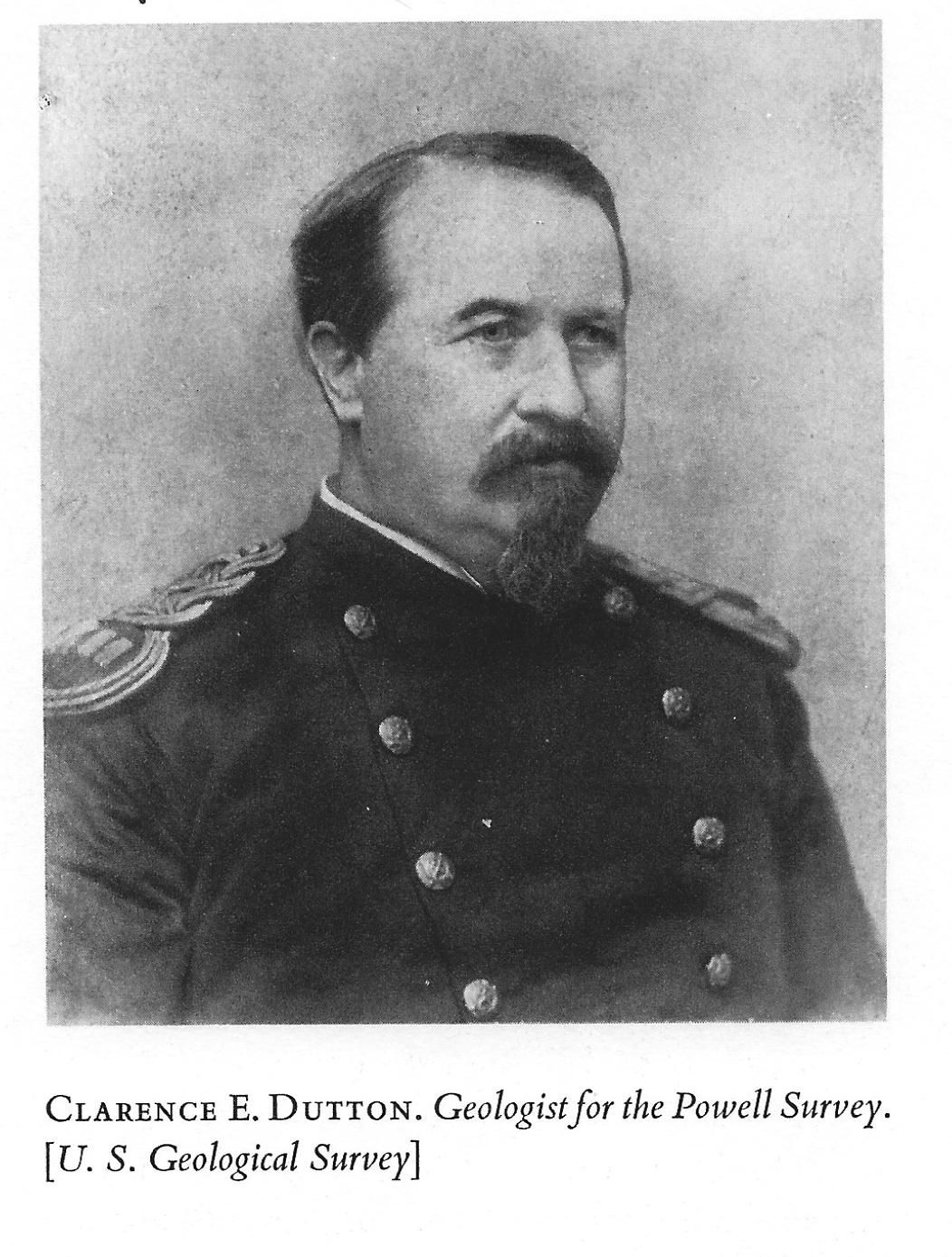Clarence spent 38 years in the United States Army.
CLARENCE EDWARD DUTTON, son of Samuel and Emily (Curtis) Dutton, was born May 15, 1841, in Walhngford, Conn He was prepared for college at Ellington, Conn In 1859 he won the "Yale Lit" medal. He was a Graduate student in New Haven in 1861 and 1862, but in September of the latter year he enlisted in the Twenty-first Connecticut Infantry and was appointed adjutant. He was wounded at the battle of Fredericksburg, but rejoined his regiment at Norfolk, Va, and was in many skirmishes and in the battle of Suffolk, Va, and later on garrison duty near Beaufort, N. C. In December, 1863, he passed an examination for a position in the ordnance corps of the regular army, and in January, 1864, was appointed second lieutenant of ordnance. He became first lieutenant in March, 1867, captain in June, 1873, and major in May, 1890 After a period of duty at Fort Monroe and at the Allegheny Arsenal, Pittsburgh, and elsewhere, he joined the Twenty-third Army Corps in Tennessee just before the battle of Harpeth River From January, 1865, to the close of the war he was in command of the ordnance depot of the Army of the Potomac. He was then stationed at the Watervhet Arsenal, at West Troy, N Y There he devoted his leisure during five years to the study of steel and of geology, and in 1869 read before the American Association for the Advancement of Science his first scientific paper, "On the Chemistry of the Bessemer Process " The following year he was transferred to the Frankford Arsenal, Philadelphia, and while there read several papers before the Franklin Institute, the American Philosophical Society, and the Academy of Sciences In 1871 he was transferred to the Washington
Arsenal, where he continued his scientific studies, until in 1875, he was detailed to the Survey of the Rocky Mountain Region under Major John W Powell, and began his geological field work in the high plateaus of Utah After three years of work there he wrote his first monograph, 'The High Plateaus of Utah " In 1878 he began the survey of the Grand Canyon district, immediately south of the high plateaus, the first year under Clarence King (Ph B Yale 1862) as director, and then under Major Powell. Three years were spent in this survey, and Major Dutton then wrote "The Tertiary History of the Grand Canyon District" In 1882 he was sent to the Hawaiian Islands, and after six months of study there he prepared his third monograph, on the "Hawaiian Volcanoes Two years of work in New Mexico, around Fort Wingate, Mount Taylor, and Zuni, led in 1884-85 to his "Mount Taylor and the Zuni Plateau " After spending two years in the survey of the Cascade Range in Northern California, he was diverted from the "volcanic fields there by the occurence of the Charleston earthquake of 1886. Through the division which he had for several years maintained at his Washington office for the collection of information about earthquakes and the aid of Major Powell he secured the material for "The Charleston Earthquake/' which he finished in 1887. After this he was in charge of the new irrigation surveys in the West till the resignation of Major Powell, and upon his own request was returned to military duty in September, 1890 As a member of a board on gun factories, he journeyed in the West and South and then employed a leave of absence in a trip to Central America. On his return he was ordered in 1891 to the command of the San Antonio (Texas) Arsenal. After eight years there he was made first assistant to the chief of ordnance at the Washington office, but February 7, 1901, after over thirty years of service, his application for retirement was granted.
Besides the monographs mentioned, he published other geological papers, and in 1904 a volume, "Earthquakes," which was republished in England.
He was a member of the American Academy of Political and Social Science, of the American Philosophical Society, and of the National Academy of Sciences
After his retirement Major Dutton devoted himself largely to writing, though suffering much from ill health. He resided at Englewood, N J, where he died of arteriosclerosis with complications, January 4, 1912. He was 70 years of age.
He married at New Haven, Conn, April 18, 1864, Emeline C, daughter of John Newton and Charlotte Rogers (Bromley) Babcock, of New Haven. Mrs Dutton with their son, who bears his father's name, survives. Their daughter died in 1903, leaving a son, William A. Prime, Jr. (B A Yale 1911).
Major Dutton's brother, Colonel Arthur Henry Dutton, of the Twenty-first Regiment Connecticut Volunteers, was a student in the Sheffield Scientific School two years before entering West Point.
Clarence spent 38 years in the United States Army.
CLARENCE EDWARD DUTTON, son of Samuel and Emily (Curtis) Dutton, was born May 15, 1841, in Walhngford, Conn He was prepared for college at Ellington, Conn In 1859 he won the "Yale Lit" medal. He was a Graduate student in New Haven in 1861 and 1862, but in September of the latter year he enlisted in the Twenty-first Connecticut Infantry and was appointed adjutant. He was wounded at the battle of Fredericksburg, but rejoined his regiment at Norfolk, Va, and was in many skirmishes and in the battle of Suffolk, Va, and later on garrison duty near Beaufort, N. C. In December, 1863, he passed an examination for a position in the ordnance corps of the regular army, and in January, 1864, was appointed second lieutenant of ordnance. He became first lieutenant in March, 1867, captain in June, 1873, and major in May, 1890 After a period of duty at Fort Monroe and at the Allegheny Arsenal, Pittsburgh, and elsewhere, he joined the Twenty-third Army Corps in Tennessee just before the battle of Harpeth River From January, 1865, to the close of the war he was in command of the ordnance depot of the Army of the Potomac. He was then stationed at the Watervhet Arsenal, at West Troy, N Y There he devoted his leisure during five years to the study of steel and of geology, and in 1869 read before the American Association for the Advancement of Science his first scientific paper, "On the Chemistry of the Bessemer Process " The following year he was transferred to the Frankford Arsenal, Philadelphia, and while there read several papers before the Franklin Institute, the American Philosophical Society, and the Academy of Sciences In 1871 he was transferred to the Washington
Arsenal, where he continued his scientific studies, until in 1875, he was detailed to the Survey of the Rocky Mountain Region under Major John W Powell, and began his geological field work in the high plateaus of Utah After three years of work there he wrote his first monograph, 'The High Plateaus of Utah " In 1878 he began the survey of the Grand Canyon district, immediately south of the high plateaus, the first year under Clarence King (Ph B Yale 1862) as director, and then under Major Powell. Three years were spent in this survey, and Major Dutton then wrote "The Tertiary History of the Grand Canyon District" In 1882 he was sent to the Hawaiian Islands, and after six months of study there he prepared his third monograph, on the "Hawaiian Volcanoes Two years of work in New Mexico, around Fort Wingate, Mount Taylor, and Zuni, led in 1884-85 to his "Mount Taylor and the Zuni Plateau " After spending two years in the survey of the Cascade Range in Northern California, he was diverted from the "volcanic fields there by the occurence of the Charleston earthquake of 1886. Through the division which he had for several years maintained at his Washington office for the collection of information about earthquakes and the aid of Major Powell he secured the material for "The Charleston Earthquake/' which he finished in 1887. After this he was in charge of the new irrigation surveys in the West till the resignation of Major Powell, and upon his own request was returned to military duty in September, 1890 As a member of a board on gun factories, he journeyed in the West and South and then employed a leave of absence in a trip to Central America. On his return he was ordered in 1891 to the command of the San Antonio (Texas) Arsenal. After eight years there he was made first assistant to the chief of ordnance at the Washington office, but February 7, 1901, after over thirty years of service, his application for retirement was granted.
Besides the monographs mentioned, he published other geological papers, and in 1904 a volume, "Earthquakes," which was republished in England.
He was a member of the American Academy of Political and Social Science, of the American Philosophical Society, and of the National Academy of Sciences
After his retirement Major Dutton devoted himself largely to writing, though suffering much from ill health. He resided at Englewood, N J, where he died of arteriosclerosis with complications, January 4, 1912. He was 70 years of age.
He married at New Haven, Conn, April 18, 1864, Emeline C, daughter of John Newton and Charlotte Rogers (Bromley) Babcock, of New Haven. Mrs Dutton with their son, who bears his father's name, survives. Their daughter died in 1903, leaving a son, William A. Prime, Jr. (B A Yale 1911).
Major Dutton's brother, Colonel Arthur Henry Dutton, of the Twenty-first Regiment Connecticut Volunteers, was a student in the Sheffield Scientific School two years before entering West Point.
Inscription
Major U.S. Army, Son of Emily C & Samuel Dutton
Gravesite Details
Civil War Co. S 21st Regt Inf - Trans Co. H, Conn . Vol.
Family Members
Sponsored by Ancestry
Advertisement
Advertisement











